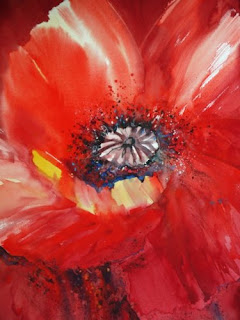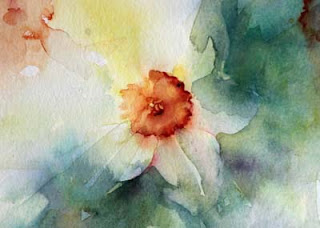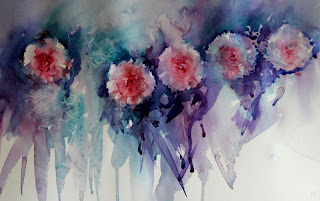The second artist I was inspired
by is Shirley Trevena (http://www.shirleytrevena.com/),
who explores the boundaries of watercolour and is regarded as one of Britain's
most innovative artists in that sense. Shirley goes against the conventional
rules of watercolour in many different ways: through her compositions, strange
perspectives, fascinating textures and, above all, the strength and vibrancy of
her colour combinations.
http://www.shirleytrevena.com/gallery/?album=4&gallery=29
I found several images in book written by Jean Haines' Watercolour Passion, some students work from University of Auckland from New Zealand and Jo Casson work I used them as a source of inspiration for my images.
All water-colourist artists
encourage me to experiment with my photographs and produce challenging and
exciting pieces of my work. They inspired me to look into, develop and
eventually create my own style. My target was to combine oil paint style with
photographs to achieve the abstract. I would like to show how we can combine digital
montage techniques with mixed media equipment only to create art paint work.
Colour was one of the most
important subjects for the painter and I find it as well fascinating, but also
at times challenging.
I started with my own images of
flowers which I used as a point of departure. The images I chose for the
project displayed clear shapes of flowers to make sure that my composition is
strong and that despite the abstract nature of the photographs, the viewer can
quickly identify their theme.
I mixed colours, textures in
unusual ways to achieve interesting atmosphere, which is different in every
picture. By mixing colours, I achieved an effect similar to what was painted by
the three artists mentioned above. In other words, the image received a quality
of painting. This quality was also ensured by vibrant and vivid colours, which
appeared in the images thanks to using textures by applying layers in
Photoshop.
When placing individual layers on
my images, I played with opacity level. This allowed me to modify an extent to
which some layers (or their parts) were more visible than others. This is how I
used colours in an innovative way, that is by making some of the colours
stronger and others more faded. By doing this, the viewer has a chance to look
at the images from a new perspective, determined by his/her fondness to
particular types of colours and their intensity.
I also combined manipulating
opacity levels with other textures, e.g. fingerprint, sponge, broken glass and
water splash texture. By resizing the area of the texture, I was able to
achieve an effect of paint drops and brush strokes, in a similar way that is
done by such artists as Shirley Trevena.
Another technique of my choice
was painting with the mixer brush (wet and dry) to blend colours. Similarly to
other techniques, this one contributed to the effect of brush painting and
brush strokes. As a result, the images can be seen as a sort of hybrid between
painting and digital image. At the same time, the colour level feature in
Photoshop allowed me to experiment with the depth and intensity of colours and
to choose the ones which I thought will be captivating for the viewer. This is
mainly achieved by adding to ‘surreal’ quality of the images.
My images





.jpg)














































That is a seriously impressive quantity of good quality images Agnes. Your treatment of the white rose fits in with the others here, but I prefer the other one, without the texture, as an individual image. I now have to nag you about planing and an evaluation.
ReplyDeleteThank you very much for that. I've added planning and evaluation. Is it better now? I should be able to bring you my sketch book towards the end of the week (probably Thursday).
DeleteYour research is very thorough and you have used some unusual artists as inspiration. It is good to see you crossing media to widen your visual vocabulary. When you bring your sketch book in we will have to have a talk about where you see your work progressing then I would e happy to give you a distinction for this work. (subject to verification of course)
Delete